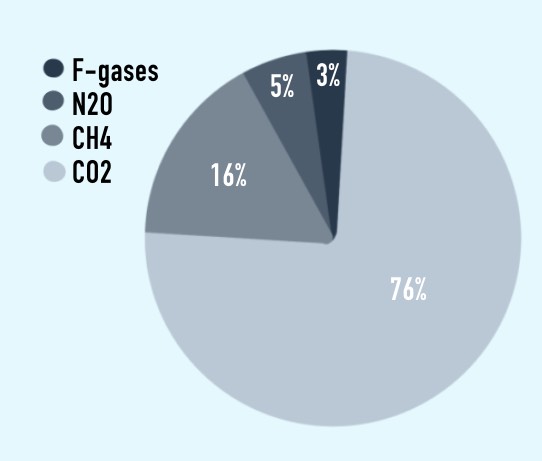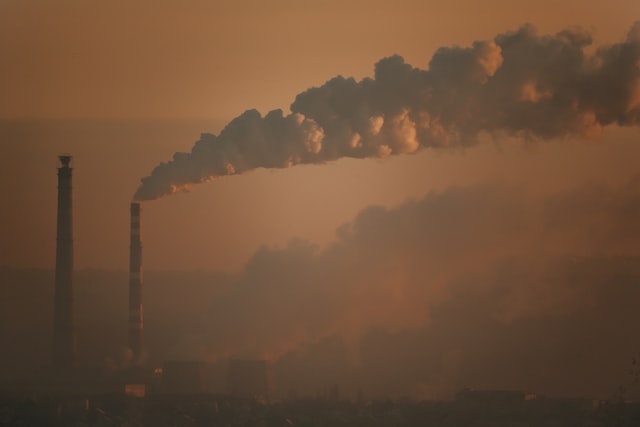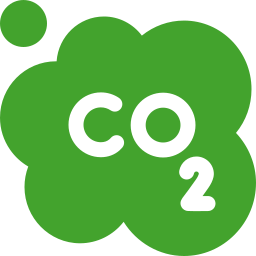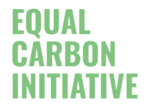Greenhouse gases
Gases in the atmosphere that easily transmit radiation in the visible range (the energy of the Sun) and absorb (delay) radiation in the
infrared range (thermal radiation from the Earth’s surface). The presence of greenhouse gases (GHGs) in the atmosphere leads to the
greenhouse effect, to an increase in the average temperature of the Earth, which contributes to global climate change.
The following GHGs, affect climate change: carbon dioxide (CO2) – 76%, methane (CH4) – 16%, nitrous oxide (N2O) – 5%, other gases – 5%. GHG
volumes measured in tons are converted into CO2 equivalent (СО2е) with average conversion factors: methane – 28, nitrous oxide
– 298


Global warming problem
Humanity encountered the problem of climate change leading to global warming. One of the leading reasons thereof is the increase in the
content of greenhouse gases (GHGs) in the Earth’s atmosphere, as a result of human activities (anthropogenic factor)
The essence of the fight against greenhouse gases
Measures taken since the early 1990s. in accordance with the UN
Framework Convention on Climate Change, the Kyoto Protocol and the Paris
Agreement, to reduce GHG content, or at least reduce emissions due to the
anthropogenic factor over 30 years, has not yielded results. The content of
GHGs in the atmosphere still increases, by about 0.5% per year, GHG
emissions are constantly growing, decreasing only as a result of local
deindustrialization (in the 90s) or global pandemics (COVID-19) in 2020.

In today’s world, the cost of GHG de-emission is completely detached from the market
•GHG de-emissions is the process of reducing emissions, as well as
capturing and storing GHGs relative to the 2019 baseline. Baseline –
GHG emissions in the world, region, country, city, village, household,
company, manufacturing unit as of 2019 – a point for assessment,
verification and registration of CU.
•The results of de-emissions within the framework of climate projects
(C-projects), assessed and verified by professional organizations and
audit companies, are issued in the form of carbon units (CU) and
entered into carbon registers.
•Today, CU produced in implementation of various types of
projects (forestry, renewable energy, household waste
processing, etc.), in different industries and regions, evaluated
by different verifiers, have different prices. The CU registration
process is unnecessarily bureaucratic, costly, and dependent on slow-
moving political systems. In Asia, Europe, the US and the Middle East,
the value of the same underlying asset, the de-emission of one metric
ton of GHG in CO2e, can vary greatly.
Why Take Action To prevent The Climate Change?
It became apparent to world leaders that as our population increases, technology advances, and the number of products in the industry widens, the number of greenhouse gasses (GHG) in the atmosphere worsens. In 2020, the atmosphere carried over 2,6 trillion tons of greenhouse gasses, while larger countries were emitting more than twenty billion tons of carbon dioxide (CO2).
However, it is also very difficult to have the most advanced technology companies, first-world countries, and various production houses limit the number of GHG released into the atmosphere without destroying profitability. Because of these, the carbon market used tradeable assets like carbon credits, signifying the number of greenhouse gasses each corporation emits.
Unfortunately, carbon markets have become political, teetering along the lines of abuse, and entities have found a way to get around these restrictions (offsetting). These problems are exactly what the Carbon Equality Initiative is about. This article will introduce the CEI and the numerous principles and initiatives designed to limit the carbon footprint of not only corporations but every individual.

Implementation of Equal Carbon Initiative principles Takes place in two stages
Anarchic
Without the participation of the state, as a public
movement of climate activists, which are individuals, media people,
towns, cities, companies, entire countries, promoting the principles of
real accounting for the impact of human activity on the Earth’s
atmosphere, as opposed to conditional bureaucratic procedures;
Regulated
When the principles of the Initiative can become the basis of
the National carbon regulation mechanisms of countries or their
associations, primarily in South and Southeast Asia, the Middle East,
Africa and Latin America.

Carbon footprint assessment and verification are carried out by:
• For large companies – audit, appraisal and verification companies, the results of which are recognized by the Initiative (DecarT).
• For medium and small enterprises, as well as households – within the framework of self- regulatory organizations, public and environmental initiatives, competitions by regions, countries or industries using relevant methods and reference tables under the control of professional companies, the assessment (verification) of which is recognized by DecarT.
• For climate activists, media personalities – in the application on the DecarT website based on the questionnaires they fill out and built-in counters, thanks to which specific individuals know their carbon footprint and can offset it by buying and using (burning) DecarT.
About Us
One Touch Of Nature Makes The Whole World Kin
The Equal Carbon Initiative is the first blockchain-based initiative in the fight against climate change with its single cryptocurrency, transparent relevant methodology, uniform carbon units (CU) registration rules, GHG de-emission procedures, single carbon units register, rules for recognizing the competence of independent bodies for assessing the contribution and reducing the carbon footprint, and carbon units registration arbitration.
Goals
The goals of combating irreversible climate change are:
Reduction
Reduction of GHG (Green House Gas) in the atmosphere and de-emission, transition to a low-carbon footprint development model.
Prevention
Prevention of additional non-anthropogenic GHG emissions into the atmosphere & Reduction of the negative impact of higher GHG content in the atmosphere on climate.
Enhance
Enhancing the absorption capacity of land and oceans surfaces as natural de emitters.
The Equal Carbon Initiative's basic goal is to combat irreversible climate change.
The equality concept of the Initiative can be broken down into three distinct approaches:

Each Ton is Equal to Another
Each ton of CO2 emission is equal to another, regardless of project type and of how in which country or industry it was obtained, and which company assessed and verified it.

Everyone Participates
Small businesses and households participate in the de-emission process along with large corporations, NGOs, states and their associations.

Reissuance
Old (registered before 2012) CUs after their reissuance and re-verification are taken into account along with new CUs.
Why Take Action to Change the Climate?
Through the 2015 Paris Agreement, world governments committed to curbing global temperature rise to well-below 2°C above pre-industrial levels and pursuing efforts to limit warming to 1.5°C. In 2018, the Intergovernmental Panel on Climate Change warned that global warming must not exceed 1.5°C to avoid the catastrophic impacts of climate change.
To achieve this, GHG emissions must halve by 2030 – and drop to net-zero by 2050. We have limited time for action and the private sector has a crucial role to play – every sector in every market must transform. Organizations with science-based targets are already cutting emissions at scale; all businesses must now join them.

How Is the World Fighting Climate Change Now?
It became apparent to world leaders that as our population increases, technology advances, and the number of products in the industry widens, the number of greenhouse gasses (GHG) in the atmosphere worsens. In 2020, the atmosphere carried over three trillion tons of greenhouse gasses, while larger countries were emitting more than twenty billion tons of carbon dioxide (CO2).
However, it is also very difficult to have the most advanced technology companies, first-world countries, and various production houses limit the number of GHG released into the atmosphere without destroying profitability. Because of these, the carbon market used tradeable assets like carbon credits, signifying the number of greenhouse gasses each corporation is allowed to emit.
Unfortunately, carbon markets have become political, teetering along the lines of abuse, and entities have found a way to get around these restrictions (offsetting). These problems are exactly what the Carbon Equality Initiative is about. This article will introduce the CEI and the numerous principles and initiatives designed to limit the carbon footprint of not only corporations but every individual.
